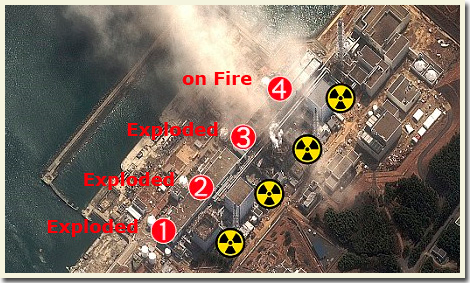The Fukushima Daiichi nuclear disaster occurred in Japan on March 11, 2011. It all started with one of the largest earthquakes in the recorded history of the world. It was a rare double quake with a duration of 3 minutes. The earthquake caused a 15 metro major tsunami, causing nearly 20,000 deaths and over a million buildings destroyed. Electricity, gas and water supplies, telecommunications and railway services were all affected and completely shut down. These disruptions severely affected the Fukushima Daiichi nuclear power plant causing a loss of all power and also a release of radioactive materials from three reactors. Fukushima Daiichi reactors 1,2, and 3 were shut down. Units 4, 5, and 6 were not operating at the time, but were still affected. The units lost the ability to maintain proper reactor cooling and water circulation functions. The accident was rated a 7 out of 7 on the International Nuclear and Radiological Event Scale due to high radioactive releases over a span of 4-6 days. After two weeks the three reactors were stable with water addition. Many weeks were spent focusing on restoring heat removal from the reactors and coping with overheated spent fuel ponds. Fortunately, there were no deaths or cases of radiation sickness from the nuclear accident, but over 100,000 people were evacuated from their homes.
Fukushima Daiichi reactors
The Fukushima Daiichi reactors were GE boiling water reactors of an early 1960’s design by GE, Toshiba and Hitachi. The six reactors that were affected in the accident had different powers. Unit 1 reactor power was 460 MWe, 748 MWe for units 2-5, and 1100 MWe for unit 6.
Inside a Fukushima reactor:
After Japan’s nuclear plants were shut down after the accident, The Nations greenhouse gas emissions spiked, as utilities relied more on fossil fuels for energy, like coal and natural gas. The Japanese government is working to restart their reactors despite public opposition.
The New National Energy Strategy is expected to reduce their oil dependency rate to 40% or less by 2030 from the current 50% and secure energy resources abroad through the fostering of more powerful energy companies.
Sources:
http://www.world-nuclear.org/info/Safety-and-Security/Safety-of-Plants/Fukushima-Accident/
http://mashable.com/2014/03/11/three-years-after-fukushima/
http://www.atimes.com/atimes/Japan/HA13Dh01.html

It is so terrible what happened in Fukushima. It’s amazing how sensitive nuclear reactors are too. The Government handled the accident very well though, and is now improving their technologies. Hopefully nothing like this happens again! or in the US!